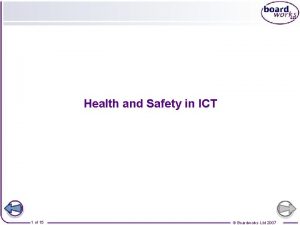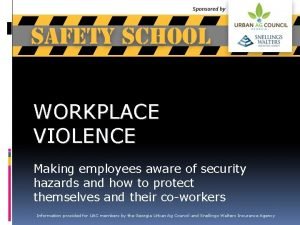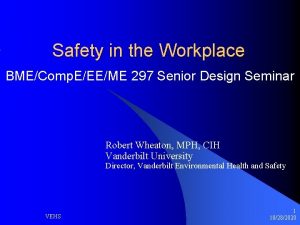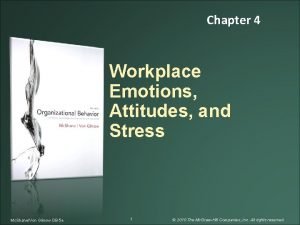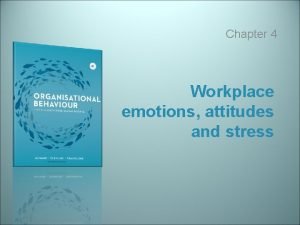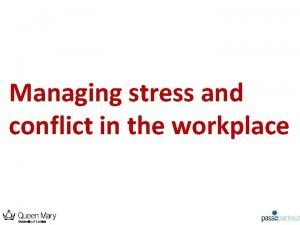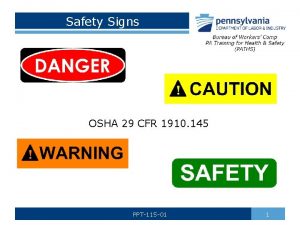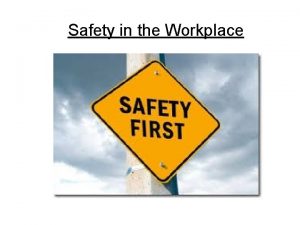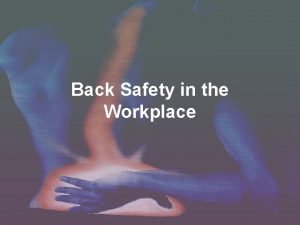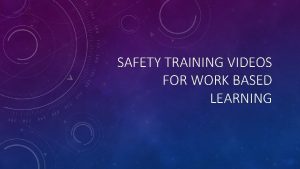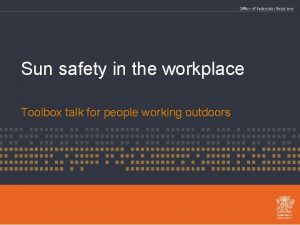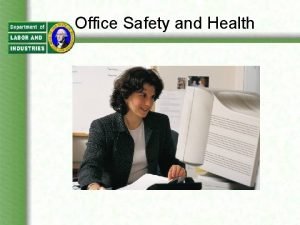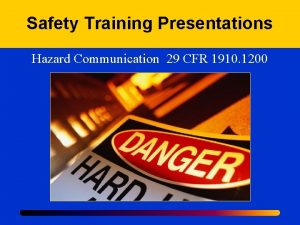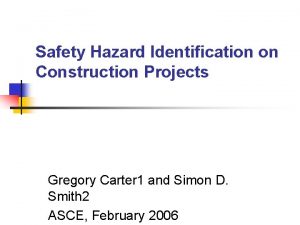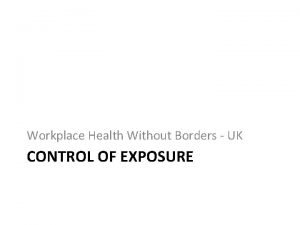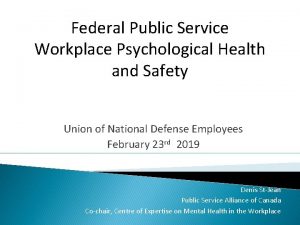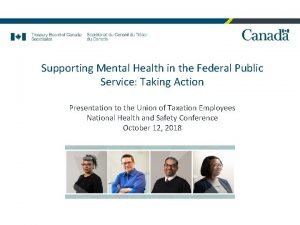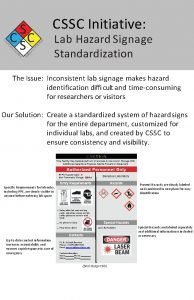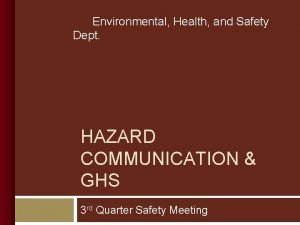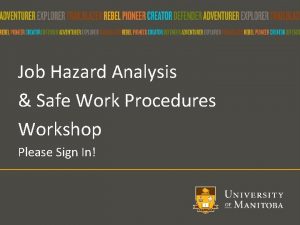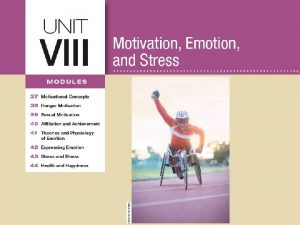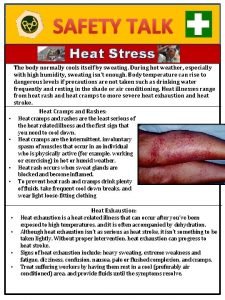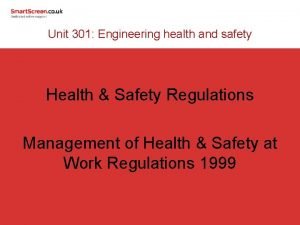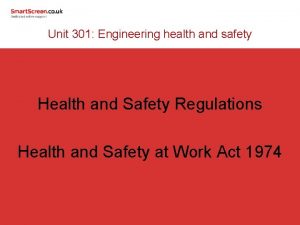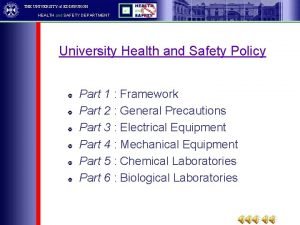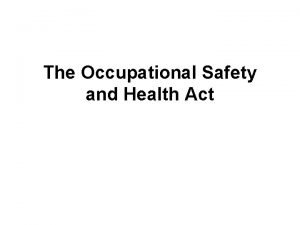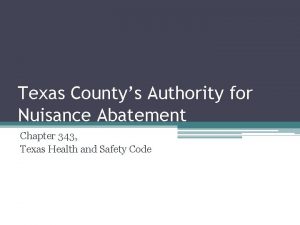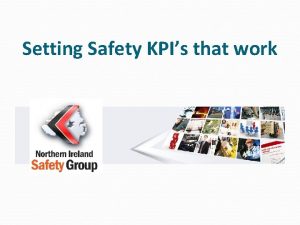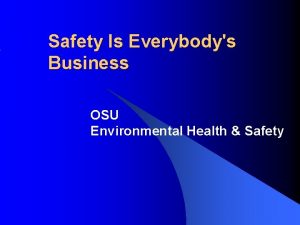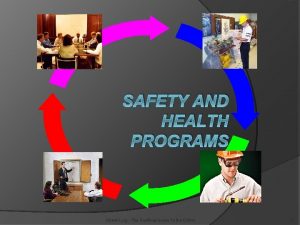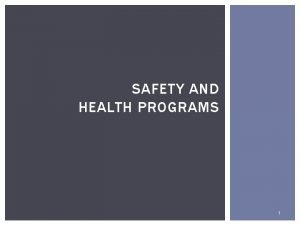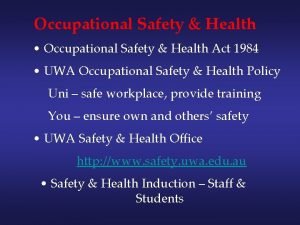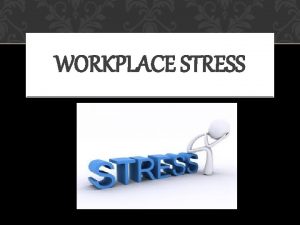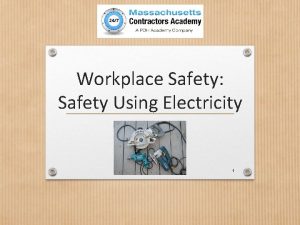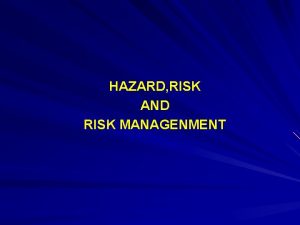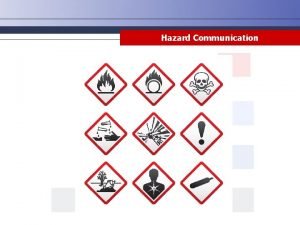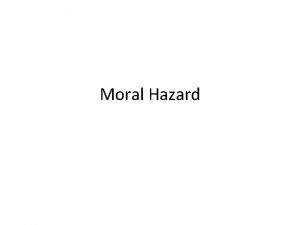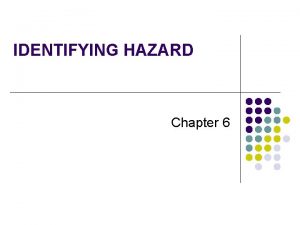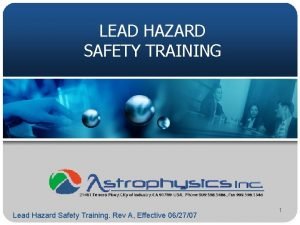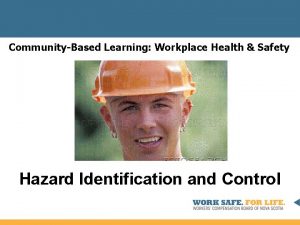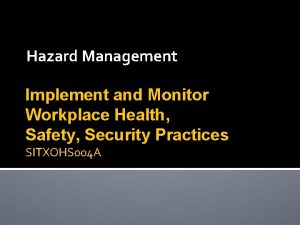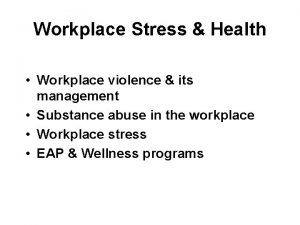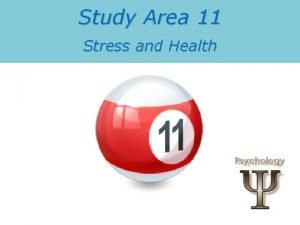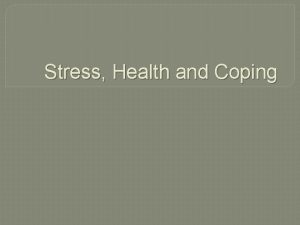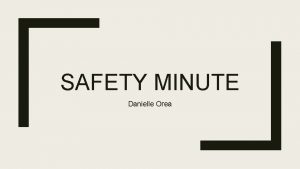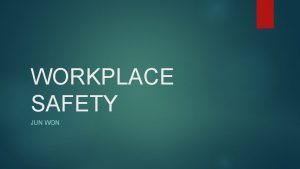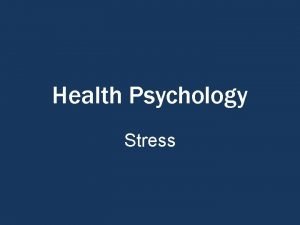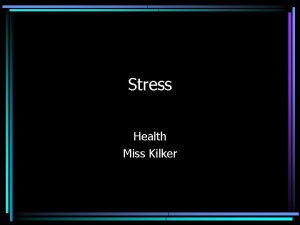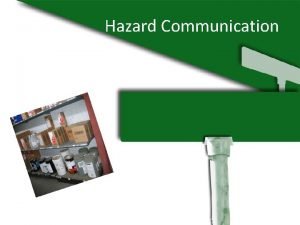Workplace stress as a health and safety hazard











































- Slides: 43

Workplace stress as a health and safety hazard • Mental Injury Tool Group (MIT) Terri Aversa, OPSEU

Dr. David Posen, Is Work Killing You? : A Doctor's Prescription for Treating Workplace Stress, House of Anansi Press, Toronto (2013)

Is Work Killing You? “There are two ways to reduce the stress. One is to get rid of what's there. Exercise, meditation, relaxation, a massage, medication such as tranquillizers, diversion and distraction, humour, laughter, and play can all be helpful. However, if you don't eliminate the source of stress (overwhelming workload, unrealistic deadlines, a difficult boss), you can jog and eat broccoli till the cows come home and you won't get ahead of the problem. The stress will keep accumulating as fast as you can dissipate it. The best way to deal with stress is to get rid of what's there and eliminate the source. ” (page 291) Dr. David Posen, Is Work Killing You? : A Doctor's Prescription for Treating Workplace Stress, House of Anansi Press, Toronto (2013)

Is Work Killing You? “The first book ran the risk of being seen as blaming the victim, although, fortunately, no one took it that way. This book runs the risk of blaming the organization for all the stress. The truth is somewhere in the middle. It's a shared responsibility, but I have observed that an increasing amount of the stress in recent years has been company-driven and organizations are doing precious little to own up to the damage they're causing on a daily basis. ” (page 321) Dr. David Posen, Is Work Killing You? : A Doctor's Prescription for Treating Workplace Stress, House of Anansi Press, Toronto (2013)

MIT group • • • • Laura Lozanski, CAUT Terri Aversa, OPSEU Sari Sairanen, UNIFOR David Chezzi, Andréane Chénier, CUPE Nancy Johnson, Erna Bujna, ONA Valence Young, ETFO Gerry Le. Blanc, Sylvia Boyce, USW Janice Klenot, UFCW 175/633 Jane Ste. Marie, John Watson, OSSTF Kathy Yamich, Workers United Union Charlene Theodore, OECTA Ashley Mc. Culloch, Carleton University Andy King, LOARC (Labour, OHCOW, Academic Research Collaboration) • Maryth Yachnin, IAVGO • Alec Farquhar, Kristen Lindsay, OWA • John Oudyk, Ivan Bauer, Curtis Vander. Griendt, Ted Haines, Mark Parent, Andre Gauvin, Brenda Mallat, (OHCOW)

http: //www. ohcow. on. ca/mit

Action on Workplace Stress: Mental injury prevention tools for Ontario workers Worker Action Resource Kit – Structure • PART 1—Why should we care? • PART 2—“Workplace Stress”: Assumptions, terminology, and approaches • PART 3—What are other jurisdictions doing? • PART 4—What are my legal rights and protections? (focus on Ontario) • PART 5—What does a workplace action plan look like? • PART 6—Resources 10 OCTOBER 2012 Borrowed from Worker Action Resource Kit Presented by Syed Naqvi 7

App • In partnership with the CCOHS, we’ve created an app that allows you to do the survey and have your own personal score

Terminology and Frame Workplace Stress Cause? ? ? Effect? ? ? Psychosocial Hazards CAUSE/CONTRIBUTOR Home Work Mental Distress Undiagnosed Effect • Heart attacks • Musculoskeletal • Strain • etc Diagnosed PTSD • Depression Anxiety disorders • • • Other trauma disorders First Responders?

Where interventions can be focused or directed to improve mental health…. . Examples? At the person? ? At how the organization functions

Biomedical Model: …disease the result of disruption of psychological processes wherein subjective perceptions, behaviors and personality factors ( e. g. , neuroticism) are of primary importance (i. e. , disease proceeds from the individual to the environment). ” Person affects environment Occupational Psychology P. Schnall, Session # 1 – Part 1: Introduction to “Work and Health”, UCLA SPH EHS 270/CHS 278 Spring 2009 (March 31, 2009)

Social Epidemiological Model: “negative health outcomes (illnesses) are due to the impact of social epidemiologic factors (in general class, work, race and gender)” – Occupational Sociology Environment affects person P. Schnall, Session # 1 – Part 1: Introduction to “Work and Health”, UCLA SPH EHS 270/CHS 278 Spring 2009 (March 31, 2009)

Primary At the source Secondary Minimize its effect Tertiary Assist afterwards

Common ways to address worker mental health prevention level Aimed at individual Organizational response primary – coping, and building resilience Work factors skills secondary - wellness, awareness, screening relaxation techniques peer programs (mindfulness) tertiary - therapy, Incident debriefing, Return EAP, counselling, to Work, benefits medication, support

Organization Factors (Psychosocial Hazards) Wellness programs, awareness training Employee Assistance Program Accommodate the worker (RTW)

EU Directive 89/391/EEC 2. The employer shall implement the measures referred to in the first subparagraph of paragraph 1 on the basis of the following general principles of prevention: (d) adapting the work to the individual, especially as regards the design of work places, the choice of work equipment and the choice of working and production methods, with a view, in particular, to alleviating monotonous work and work at a predetermined workrate and to reducing their effect on health. (g) developing a coherent overall prevention policy which covers technology, organization of work, working conditions, social relationships and the influence of factors related to the working environment;

http: //www. av. se/SLIC 2012/

Ontario Health and Safety Legislation • Employers must take “every precaution reasonable in the circumstances for the protection of a worker”

the new CSA Standard Z 1003 -13 http: //shop. csa. ca/en/canada/occupational-health-and-safety-management/cancsa-z 1003 -13 bnq-97008032013/invt/z 10032013/? utm_source=redirect&utm_medium=vanity&utm_content=folder&utm_campaign=z 1003

Vision A workplace that promotes workers’ psychological well-being and allows no harm to workers mental health. Key Drivers Risk Management Cost Effectiveness Recruitment & Retention Excellence & sustainability Strategic pillars Prevention Promotion Resolution Psychological support Organizational culture Clear leadership and expectations Civility and respect Psychological job fit Growth and development Recognition and reward Involvement and influence Workload management Engagement Balance Psychological protection Supportive physical environment

COPSOQ Copenhagen Psychosocial Questionnaire …. . a mixed approach Demand/ control Effort/ reward Justice/ respect http: //www. arbejdsmiljoforskning. dk/Sp%C 3%B 8 rgeskemaer/Psykisk%20 arbejdsmilj%C 3%B 8. aspx? lang=en

COPSOQ Psychosocial Hazards:

Should we even use a survey? • If you’ve got lots of good quality data, reviewing absences, Sickness & Accident data might be a good place to start • If you’re serious about improving things and/or you want evidence to prove your case, doing a survey properly could help Ø however, a survey needs a solid basis of commitment (all levels) and a comprehensive administration plan

Don Dilman’s approach to maximizing survey response: 1) Lay the groundwork – get endorsements/buy-in; set up steering committee; define relationships to JH&SC, union, employer involvement; sort out logistics (electronic or paper, who’s in charge of what, confidentiality, data management/security, when do we report results, what do we do next – long term objectives) 2) Pre-survey announcement (1 -2 weeks prior) with endorsements 3) Distribute survey – fanfare? ; provide time, space, incentives? 4) 1 -2 weeks later send out reminder 5) After another 1 -2 weeks send a 2 nd reminder. Ø 6) if response rate is poor (<66%) you may have to consider a stronger intervention (i. e. start “nagging” people directly) After a reasonable period of time (and depending on response rate) set a closing date and send out a final notice with an urgent message.

The “Soft Guidelines” of COPSOQ 1. Never start a survey of the psychosocial work environment unless there is a clear intention of taking action if indicated. 2. Answering the questionnaire is voluntary, but a response rate below 60% is unsatisfactory and a sign of poor psychological climate at the workplace. 3. All respondents are anonymous. If scores are calculated for groups of less than 15 persons all group members should give their consent. 4. All employees have the right to see and discuss the results. 5. Management as well as supervisors and workers should participate and be committed during the whole process. TS Kristensen, “The “Soft Guidelines” of NIOH, Copenhagen. How to go from survey to action. ”, The Eighth International Congress of Behavioral Medicine. Mainz, Germany. August, 2004.

The “Soft Guidelines” of COPSOQ 6. It is important to distinguish between basic conditions of work that are “part of the job” and factors that could be changed. Do not try to change what cannot be changed and do not accept what should be changed. 7. There are no standard solutions to the problems. Solutions should be developed locally and integrated in the other activities of the organization aiming at increased productivity and better quality. 8. If interventions are made, it is a good idea to repeat the survey after 1 -2 years in order to see if the intended improvements have occurred. 9. Many workplaces will benefit from surveys with regular intervals as part of the overall concept of the “learning organization” and the “development” work. 10. The survey results should be seen as a tool for dialogue and development – not as a “report card”. TS Kristensen, “The “Soft Guidelines” of NIOH, Copenhagen. How to go from survey to action. ”, The Eighth International Congress of Behavioral Medicine. Mainz, Germany. August, 2004.

7 -Step Plan 2. Gather emails 1. Select Coordinator 3. Local endorse and announce 4. COPSOQ Blast 7. Workplace Action Plan 5. Data gathering 6. Strategize Results

Progress to Date: • OPSEU campaign of 55 bargaining units for a total of over 2200 completed surveys (pilot in Spring 2012, full launch in Spring 2013), and 6 other bargaining units (from Apr 2012 to Sept 2013) for a total of just over 200 completed surveys. – A couple of these were “spontaneous units” where someone got a hold of the survey, copied it and distributed among their members and came to us to help with the analysis. • There about another 6 bargaining units in the organizational stage right now.

“The Air is An intervention in different Community Nursing…here” • Workers from a community nursing organization used the Copenhagen Psychosocial Questionnaire (COPSOQ) to identify the top three workplace factors that were statistically shown to be affecting their self-reported health. • Then the workers (with the assistance of their union and the JHSC) collaborated with the employer to: – – reduce emotional demands, address quantitative demands, and reduce workplace bullying. In the end, work was changed to a geographic model and the organization adopted a collaborative and supportive management style.

A study to examine how reps get success –because the law won’t cut it on workplace stress or its outcomes • Labour OHCOW Academic Research Collaboration got research funded: – Alan Hall, University of Windsor (now St Mary’s Newfoundland) – Andy King, University of Ottawa (former USW) – Wayne Lewchuk, Mc. Master University – Syed Naqvi, OHCOW – John Oudyk, OHCOW

Type 1 Technical Representation Focus on activities such as inspections, meetings, reports—technical and traditional OHS things • Reliance on the law to push employers • Focus on legislative requirements • These are the ones who rely on litigious strategies to try to win changes Will this work for occupational stress?

Type 2 Knowledge activists actively and consciously collect and use scientific, legal, and expertise-based knowledge to persuade and pressure employers to address not only traditional health and safety issues but also complex ones—LIKE STRESS • • • Representatives These reps do not dismiss law, meetings, inspections and other technical aspects of the role—rather they use them strategically These activists use social skills, links, alliances, information, and any tools available to them as strategic choices and to their advantage in seeking their change They bring solutions—and compromise

Knowledge Activists…. . Research prepare Bring solutions Finesse management Educate the employer Be persistent build your case Knowing and using the law Recognize the power and interests in the room Talk to people face to face Cultivate strategic relationships Insert heart and common sense Assertive yet polite Working with different people Ask for advice but use in tandem with your own mind Side by side with workers www. worksmartontario. gov. ca 33

Third Group Transitional Representatives • spend much of their more limited overall time attending meetings, dealing directly with workers issues, getting training and education for themselves, and doing research, with little attention to inspections or reports *transitional in that many of these representatives are newer to representation and show signs of going either way – technical or knowledge activist).

5 Steps: 1. Learn: familiarize yourself with the basics; deepen your understanding, share your awareness; identify resources 2. Organize: you can't do it alone, get support/buy-in, establish a working group 3. Assess: select tool(s); implement, do it carefully and well; consider the results and pick your key issues 4. Change: consider advice/ideas and figure out which ones fit with your workplace; select the changes you want to try and sell them to your supports; implement, do it carefully and well 5. Evaluate: give it some time, then use tool(s) (the same as before? ) to re-assess the situation; find out what seemed to work and what did we learn; identify strengths, gaps, new questions and start the cycle again

JHSC or H&S REP Action WORKERS MIT/OHCOW UNION Employeremployee relations • • • Recommendations Surveys Group brainstorming Negotiations (+ CA) Grievances Collective activity Supporting co-workers 7. Workplace Action Plan Ontario Prevention and compensation systems

Ca Language ideas • That the employer shall take reasonable precautions to prevent psychosocial hazards from affecting workers’ health • That the employer engage and consult with the union in identifying strategies to improve psychological health and safety at the workplace

CA as a Health document • • Vac time off, staffing levels and replacement Sick leave benefits, fringe benefits H&S, ergonomics Human rights language Workload language (process) Identify and address psychosocial factors at work

Psychologically safe workplaces • Union committees and the CA • Joint health and safety committees and health and safety representatives and the Occupational Health and Safety Act • Address supports for the individual as well as address organizational issues

ILO Stress Prevention: • checkpoint format • lists specific hazards • identifies prevention strategies http: //www. ilo. org/global/publications/books/forthcoming-publications/WCMS_168053/lang--en/index. htm

English version of SOBANE psychosocial screening & observation tools www. deparisnet. be/PSY/Eng/Sobane_guide_psychosocial_aspects. pdf

SOBANE checklist example:

Terri Aversa OPSEU Health and Safety Officer 100 Lesmill Road Toronto 1 -800 -268 -7376 ext 8774 taversa@opseu. org QUESTIONS……………? ?
 Ict health and safety
Ict health and safety Workplace hazard
Workplace hazard Eeeme
Eeeme Workplace emotions attitudes and stress
Workplace emotions attitudes and stress Workplace emotions, attitudes, and stress
Workplace emotions, attitudes, and stress Managing stress and conflict in the workplace
Managing stress and conflict in the workplace Industrial safety signs and symbols ppt
Industrial safety signs and symbols ppt True stress and engineering stress
True stress and engineering stress Chapter 10 stress responses and stress management
Chapter 10 stress responses and stress management Safety at work vocabulary
Safety at work vocabulary Chapter 10 workplace safety procedures
Chapter 10 workplace safety procedures Back safety in the workplace
Back safety in the workplace Youtube safety videos for workplace
Youtube safety videos for workplace Toolbox talk sun safety
Toolbox talk sun safety Hazard
Hazard Knife safety in the workplace
Knife safety in the workplace Definition of axial stress
Definition of axial stress 29 cfr 1910 osha 178
29 cfr 1910 osha 178 Safety hazard identification on construction projects
Safety hazard identification on construction projects Touch current vs leakage current
Touch current vs leakage current Workplace health without borders
Workplace health without borders Federal public service workplace mental health strategy
Federal public service workplace mental health strategy Federal public service workplace mental health strategy
Federal public service workplace mental health strategy Health hazard symbol
Health hazard symbol Health hazard
Health hazard Work hazard examples
Work hazard examples Stress health and human flourishing
Stress health and human flourishing Module 43 stress and health
Module 43 stress and health Heat stress safety talk
Heat stress safety talk I shaped beam
I shaped beam Health and social care component 3 health and wellbeing
Health and social care component 3 health and wellbeing 4 cs health and safety
4 cs health and safety Health and safety at work act engineering
Health and safety at work act engineering Health and safety edinburgh
Health and safety edinburgh Occupational safety and health objectives
Occupational safety and health objectives Care certificate health and safety
Care certificate health and safety Texas health and safety code 343
Texas health and safety code 343 Six pack health and safety regulations
Six pack health and safety regulations What are safety kpis
What are safety kpis Osu environmental health and safety
Osu environmental health and safety Oshax
Oshax Benefits of a safety and health program
Benefits of a safety and health program Health and safety in hrm
Health and safety in hrm Occupational health and safety act 1984
Occupational health and safety act 1984
